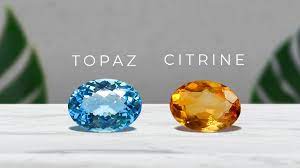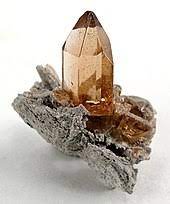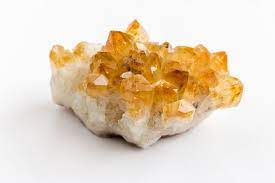November Birthstones - Topaz & Citrine
Nov 18 2022 0 Comments Tags: birthstones, blue topaz, citrine, imperial topaz, November
As someone who was born in November, we are incredibly lucky to have the choice two gorgeous birthstones; Topaz and Citrine.

Topaz comes in a range of colours while citrine is known for its wonderful yellow colour that comes in different hues and intensities. Both stones are not only affordable to buy and beautiful but they are known to posess energies that bring fortune and a warm calming energy to the wearer.
Topaz
Topaz Meaning and History
Topaz comes in a variety of colours even colourless. The word “topaz” comes from the Sanskrit word tapas which means “fire.” Topaz symbolizes love, affection, and sweetness and has a vibrant history that spans centuries and cultures.
Through millennia, topaz has held special meaning and significance to all walks of life. The ancient Greeks believed that topaz gave them strength and the ancient Egyptians wore yellow topaz which represented the sun god, Ra, due to its fiery yellow tone. From the 1300s to the 1600s, Europeans thought it could thwart magic spells and dispel anger. For centuries, many people in India have believed that topaz worn above the heart assured them long life, beauty and intelligence. Lastly during medieval times, Saxon rulers wore topaz jewellery and had stones set in their breastplates.

Roman Topaz intaglio stone 1st century B.C.–3rd century A.D. Hermes holding the kerykeion (herald's staff) and chlamys.

https://www.metmuseum.org/art/collection/search/244945
Where is Topaz found?

Today, topaz deposits are found in Brazil, United States, Madagascar, Myanmar (Burma), Namibia, Zimbabwe Mexico, Sri Lanka, Pakistan, Russia, and China.
Our Topaz comes from our home state in Brazil called Minas Gerais. As a country we are one of the most important sources of producing high quality topaz. Topaz has been mined here for centuries.

Ouro Preto the town closest to Brazil’s largest topaz mines:


Rough topaz crystal
The Colours of Topaz

Topaz comes in a lovely variety colours and hues these include colourless, light blue, yellow, orange, pink, violet, brown and very rarely, red.
Blue, once the rarest colour of topaz, is now the most common, due to an enhancement process that turns colourless topaz blue. After the raw topaz is extracted from the earth and cut, it is irradiated to brown and then heated to sky blue. This enhancement process is permanent. London Blue is the most expensive of the blue colours and is a lovely inky blue colour. Swiss Blue is such a unique colour it always reminds me of a Blue Raspberry Slushie. Sky Blue Topaz is the cheapest of the blues but it is also a really viable alternative to Aquamarine for using in a design.
The distinctly pinkish orange Imperial topaz has an aristocratic name. There are many versions of how the name comes about but in Brazil it is known to date from an 1881 visit by Brazilian Emperor Pedro II to Ouro Preto when he was gifted a reddish topaz.


Care and Cleaning
What to look for when buying?
 COLOUR The most valued topaz colours are orangey red to red, Imperial Topaz and Pink Topaz . Blue gems are widely available but the colours are outstanding and unique.
COLOUR The most valued topaz colours are orangey red to red, Imperial Topaz and Pink Topaz . Blue gems are widely available but the colours are outstanding and unique.
 CLARITY Topaz used in jewellery is typically eye clean with no visible inclusions and are slippery to the touch.
CLARITY Topaz used in jewellery is typically eye clean with no visible inclusions and are slippery to the touch.
 CUT Topaz crystals are usually columnar, and cut as oval or pear shapes to improve yield but they are available in every cut and we can customise the cut to match your needs.
CUT Topaz crystals are usually columnar, and cut as oval or pear shapes to improve yield but they are available in every cut and we can customise the cut to match your needs.
 CARAT WEIGHT Topaz often forms as large crystals. These can yield sizeable cut gems.
CARAT WEIGHT Topaz often forms as large crystals. These can yield sizeable cut gems.
Citrine
Citrine Meaning and History
Egyptians were among the first of ancient civilizations to use Citrine, while Romans associated the stone with the sun God Apollo. Roman pontiffs wore rings set with massive purple amethysts and Citrine. The ancient Greeks carved rock crystal ornaments from it that glistened like permafrost. In the 17th century, it was used as ornamentation on the handles of the swords and daggers of the Scots. It was particularly popular in colourful Scottish jewellery from the Victorian era.


A young Queen Victoria Queen Victoria's Seal.
A gilt metal Citrine seal.
Queen Victoria, whose reign saw many social and cultural changes, was known for her love of Citrine. It was commonly used to adorn kilt pins and brooches during the Victorian Era. Citrine soared again with renewed popularity during the Art Deco period, when architecture, jewellery, and clothing all took more modern turn. Starlets from the early 20th century were known to don large pieces of jewellery boasting the gemstone.
Citrine is rare in nature. Today, its attractive colour, plus the durability and affordability it shares with most other quartzes, makes it the top-selling yellow-to-orange gem.
In the contemporary market, Citrine’s most popular shade is an earthy, deep, brownish or reddish orange. Most of the Citrine in the marketplace results from the heat treatment of amethyst. With its ready availability in a broad range of sizes, Citrine is one of the most affordable and desired yellow gemstones.


Rough Citrine crystal Faceted Citrine gemstones
Where is Citrine found?


Thousands of crystals of both purple amethyst and yellow Citrine have been recovered from the Anahi mine in Bolivia. Photo: Robert Weldon/GIA
Some mines produce a unique combination of Amethyst and Citrine in the same crystal. When the two colours appear together in a fashioned gem, it is known as Ametrine.

Examples of Citrine, Amethyst, Ametrine and Quartz.
Citrine occurs naturally but is difficult to find. Instead, many Citrine stones are made by heating treating an amethyst or smoky quartz. Experts may be able to distinguish natural Citrine from man-made imitations by looking for small lines in the crystal. Man-made Citrine sometimes also takes on an orange or reddish hue. Because they are created using amethyst or smoky quartz, man-made Citrine is still a type of quartz, just one that did not develop its hue naturally.
Citrine Varieties
Yellow Citrine - Lemony yellow colour sometimes called Lemon Citrine
Golden Citrine - Golden Yellow Citrine
Madeira Citrine - Golden Orange to Reddish Brown Citrine
Fire Citrine - A trade name for Deep Orange Citrine
Palmeira Citrine - Bright Orange Citrine
Note: Lemon Quartz is not Citrine! Real Lemon Quartz is plain quartz that has been irradiated to create the pleasant lemon colour.
Some famous admirers of Citrine




Care and Cleaning.
At 7 on the Mohs scale of hardness with good toughness, your Citrine birthstone is usually durable enough for normal wear and care. It can be safely cleaned with warm, soapy water. While it is usually okay to clean your November birthstone in an ultrasonic machine, steam cleaning is risky since high heat could cause the stone to crack.
What to look for when buying?
 COLOUR Vivid yellows, reddish oranges and earth tones are popular with consumers.
COLOUR Vivid yellows, reddish oranges and earth tones are popular with consumers.
 CLARITY Eye-visible inclusions are not common in Citrine. If present, they decrease its value.
CLARITY Eye-visible inclusions are not common in Citrine. If present, they decrease its value.
 CUT Citrine might be carved, custom-cut or calibrated for jewellery use.
CUT Citrine might be carved, custom-cut or calibrated for jewellery use.
 CARAT WEIGHT Citrine is available in a wide range of sizes for setting into a variety of jewellery styles.
CARAT WEIGHT Citrine is available in a wide range of sizes for setting into a variety of jewellery styles.
0 comments






Leave a Comment